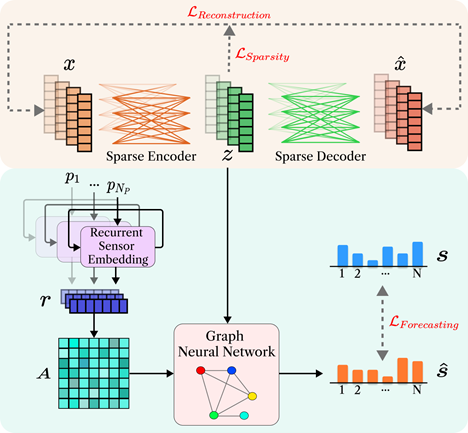우사이먼 교수 연구실 (한시호 석사졸업 학생) KDD 2022 논문 게재 승인
- 인공지능학과
- 조회수1303
- 2022-05-20

DASH (Data-driven AI Security HCI) 연구실 소속 한시호(1저자)와 우사이먼성일(교신저자) 교수의 논문 “Learning Sparse Latent Graph Representations for Anomaly Detection in Multivariate Time Series”가 데이터 마이닝 분야 최우수 국제 학회인 KDD 2022(BK21 CS IF=4)의 Applied Data Science Track에 게재 승인되었습니다.
저자들은 사이버물리시스템의 잡음이 있는 고차원 센서 데이터 내 이상징후 탐지를 위해 희소 오토인코더와 그래프 신경망을 결합하여 동시 최적화 하는 FuSAGNet(Fused Sparse Autoencoder and Graph Net) 모델을 제안했습니다. 희소 오토인코더 모듈은 원본 센서 측정값의 희소 잠재 변수를 학습하고, 이는 순환 센서 임베딩을 통해 학습된 특징 간 관계와 함께 센서값 예측을 위한 그래프 신경망의 입력으로 사용됩니다. 하나의 데이터 샘플에 대한 예측값이 정상값 대비 크게 벗어날 경우 이상징후로 취급합니다. 학습된 희소 잠재 변수와 순환 센서 임베딩 벡터는 t-SNE 시각화를 통해 모델의 설명력을 위해서도 사용됩니다.
“Learning Sparse Latent Graph Representations for Anomaly Detection in Multivariate Time Series”, a full paper by Siho Han (first author) and Professor Simon S. Woo (corresponding author) of DASH (Data-driven AI Security HCI) Lab has been accepted for publication at the Applied Data Science Track of KDD 2022 (BK21 CS IF=4), a premier international conference for data mining.
The authors proposed FuSAGNet (Fused Sparse Autoencoder and Graph Net), a model combining Sparse Autoencoder and Graph Neural Network to detect anomalies in high-dimensional, noisy sensor data from cyber-physical systems through joint optimization of reconstruction and forecasting. The Sparse Autoencoder module learns a sparse latent representation of the original sensor readings which, along with feature interdependencies learned through recurrent sensor embedding, are used as input to a Graph Neural Network module for sensor behavior forecasting. A sample of sensor readings is considered anomalous if its predicted values largely deviate from values under normal operating conditions. Learned sparse latent representations and recurrent sensor embedding vectors are also used for providing model interpretability by visualization through t-SNE plots.

FuSAGNet 구성도



